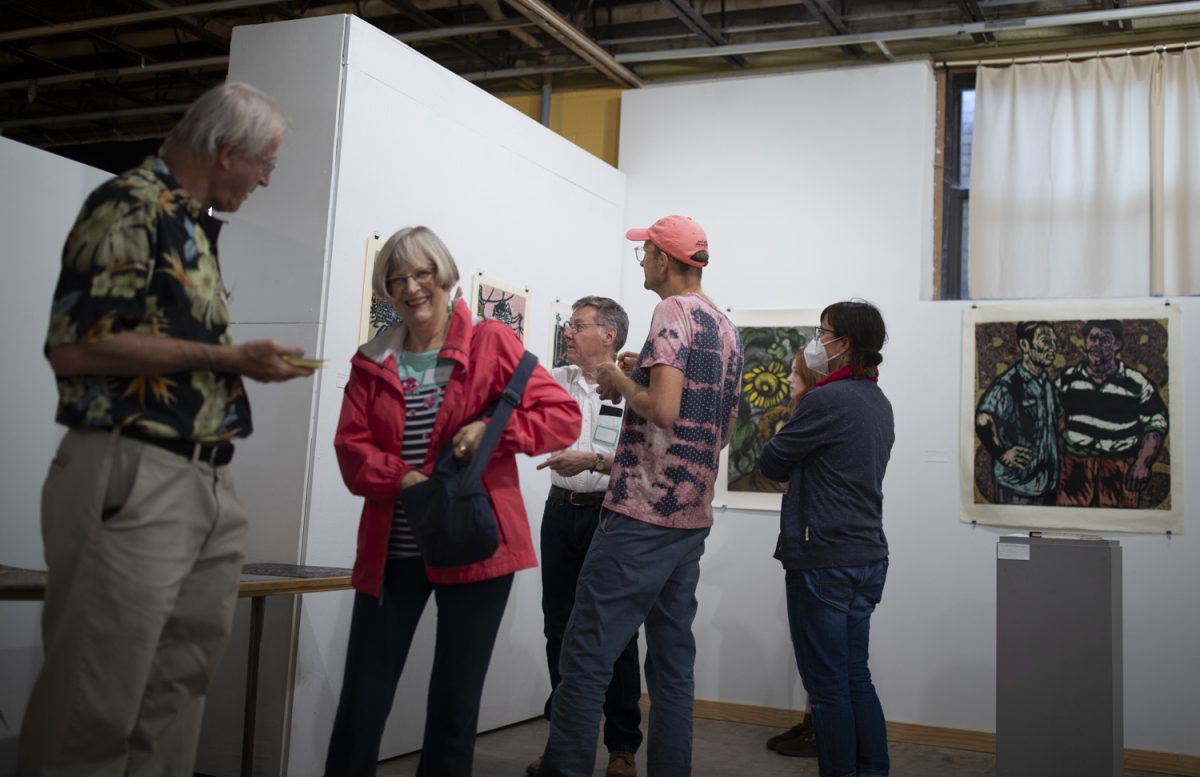On the evening of Sept. 6, David Johnson, a University of Iowa alumni, displayed a collection of prints at the ArtiFactory Gallery. The collection showcases his talent and proclivity toward the mediums of color-etching and woodcutting.
The collection comprises a variety of prints, mostly large and depicting different scenery — some of which are set in Iowa City. Every print is made of either color-etching or wood-cutting if not a combination of both. Some pieces are made of linocut, but the base medium remains the same: etching an image into a block of wood and pressing it onto a piece of paper with paint.
“It’s medieval,” Johnson joked.
On top of the overall antiquated method of art, he uses nothing but a simple wooden spoon to press the wood into the paper.
The pieces in question are beautiful, eye-catching works, highlighting Johnson’s artistic eye. Some of the most stunning prints include a piece titled “Sunflower,” which is incredibly reminiscent of Vincent van Goh’s signature style. “Birds’ Downtown” is another stunning piece, full of color and detail that makes one wonder if it was indeed just made with wood, paint, paper, and a spoon.
One piece in the collection that garnered much attention was “My Wife.” The woodcut piece had a form like many others in the collection, but “My Wife” is the only print lacking in color, consisting of simple black ink on a tan sheet.
While surprising at first, the sheer uniqueness of the piece compared to other works helps to amplify it and push it into a standout position within the collection. When asked about the difference in color of the piece, Johnson explained that he simply couldn’t find the right color after carving the image into the wood.
A print titled “The Receptionist” is a particularly mystifying one, showing a woman in a red outfit sitting in a chair. Akin to “Sunflower,” “The Receptionist” is very reminiscent of van Goh’s art style, down to the shading that adds depth to the image.
The number of pieces on display raised the question of how long crafting a collection like this took, especially considering the tedious process of crafting one print.
RELATED: A snapshot of history: ArtiFactory unveils 9/11 memorial gallery
“I weeded the collection down from about 400 prints to about 30… the entire collection was created over 38 years,” Johnson said. “That means the oldest print here was done in ‘86.”
Alongside the large-set prints in the collection, a standout item was Johnson’s accordion books, made in the same style as the large prints. Not only are the accordion books made in a fun, artistic structure, but Johnson referenced the works of Rembrandt and the small scale the Dutch artist worked at while describing his love for the books.
Johnson explained that where the large prints can take up to a month to complete, the accordion books are finished much faster, and people tend to take them more seriously if they are composed in the form of a book.
If there is any inclination to know about what inspired this piece, Johnson lays it all out in a statement about his art. He names the University of Iowa’s own Elizabeth Catlett and explains how her ideas inspire his work.
“[I believe in] drawing life and the attempt to make a graphic representation of our world,” Johnson said in a quote on ArtiFactory’s website.
The collection shown at ArtiFactory is but a mere sampling of that belief, as Johnson offers the public a glimpse into so many different scenes of life from so many different perspectives, reminding people of what art is capable of.



